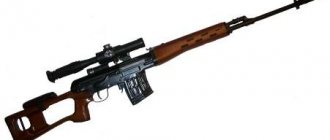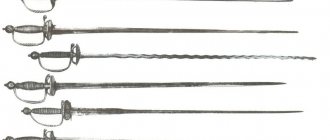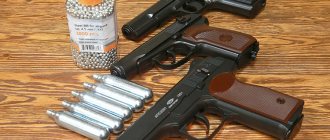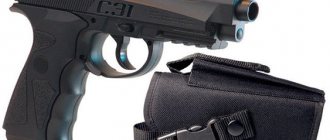Historical facts
The very concept of a sword goes back to the Celtic sword spata or, in later Spanish dialects, espada, meaning sword. By the 15th century, the sword took shape as a separate type of bladed weapon, and a century later it became established as an attribute of the nobility and townspeople. An epee is a type of late sword.
The rapier is a contemporary of the sword. Its name comes from Germanic languages and refers to a weapon worn with a suit. This is an exclusively civilian weapon, used only for unarmored fencing.
Epee and rapier.
The nature of individual and team competitions
Individual foil fencing competitions may be held according to the following principles described in the rules:
- direct elimination using a complex formula, with a preceding round of bullets and a direct elimination table, then using a direct elimination system;
- direct elimination using the full formula (in the case of the Olympic Games).
In team competitions, teams consist of 3 participants. Each member of one team faces each athlete of the opposing team. The principle of direct complete elimination applies. Teams are assigned places in the table according to a system that takes into account the positions of its three best participants in individual competitions.
Rapier Features
The rapier is a piercing weapon. By the beginning of the 16th century, its blade also allowed cutting blows, but by the end it lost this function. From the variety of design options, several characteristic features can be identified:
- Blade length from 90 cm to 115 cm, width 2.5-3 cm.
Rapier. - The shape of the blade is rhombus.
- The blade itself had a strong part, intended for parrying blows, and a weak part, piercing.
- Hilt with a heavy pommel-balancer.
- The most distinctive feature is the guard with developed wrist protection.
Requirements for equipment, weapons and clothing
Clothing and equipment must provide maximum protection and freedom of movement, and cannot allow the possibility of causing physical injury to the opponent. At the same time, clothing and equipment should not have any holes where an opponent’s blade could enter. The material of the clothing must be durable and not cause the tip to slip. The color of clothing in the body area is light. The fabric must have a tensile strength of at least 800 N.
To protect the upper parts of the body, a mandatory item of clothing is a side cover. Trousers must have fastenings below the knees. Gaiters should completely cover the entire shin. Women's equipment must include a protective bra. The cuff of the glove should reach halfway up the forearm. The gap between the mesh cells in the mask should be no more than 2.1 mm. The diameter of the mesh wire is 1 mm.
For foil fencing, a special conductive jacket must be worn over clothing, completely covering the surface of the body in any position. The bottom edge of the jacket should cover the trousers by at least 10 cm in the fencer’s “for battle!” position. The jacket must have armpits. The reverse side of such a jacket should be insulated with a special lining.
The height of the collar must be at least 3 cm. A personal wire with connectors at the ends must be stretched along the back under the jacket, then along the sleeve through the glove, joining the handle of the weapon. The wires in the cord must be well insulated and fastened.
The rapier must be designed to ensure safety in everyday conditions. Any actions aimed at changing the flexibility and sharpness of the blade are prohibited. Rapier weight – 500 g, maximum length – 110 cm.
Weapon elements are:
- Steel blade , ending on one side with a tip and on the other with a rod. The length of the blade is 0.9 m, the cross-section is rectangular. The chamfer angle of the edges is 45 degrees, the deflection arrow is from 5.5 to 9.5 cm. The electrical wire for connecting the tip to the terminal is pulled in a special channel located in the blade. The head of the tip must be cylindrical in shape, the maximum head size is 7.0 mm. The pressure required for a signal from the head is more than 500 g. The maximum stroke of the head required for a signal is 1 mm.
- Handle for fixing the hand , which may additionally have a hilt head. Its design must meet the safety requirements of the athlete and his opponent, and not have devices to enhance protection. The use of a handle for throwing weapons is prohibited.
- A protective guard with a diameter of 9.5 to 12 cm, which is fixed with the convex part forward between the handle and the blade. The guard has a connector for connecting the fencer's personal cord. In the place of the existing bulge, the guard should be smooth and matte.
There should be a special gasket inside the guard to protect your hand from wires and electrical contacts.
Sword parameters
The sword was a piercing-cutting weapon. Its first examples are not much different from later swords:
- Weight up to 1.5 kg
- The blade is about a meter long.
- The shape of the blade is varied: single- or double-edged flat, rhombic, faceted.
- The hilt initially provided full protection for the hand, but subsequently decreased in size.
Over time, the evolution of the sword led to the appearance of its civilian, “uniform” variety, not much different from the rapier, and the military sword was supplanted by the broadsword and saber.
Comparative characteristics
Epee and rapier.
In terms of their characteristics, the rapier and the sword are almost identical and weapons science does not give a clear answer about their differences:
- In history, there are many cases of mounting rapier blades on epee hilts and vice versa.
- The characteristics of both types of weapons suggest the possibility of piercing blows.
- Weight and length are often identical.
In general, it is advisable to consider their differences in the scope of application and some design features of the hilt.
Use in combat
The rapier is not a combat weapon, but a dueling weapon and a weapon of self-defense. Therefore, its use is limited to fights. The thinness and fragility of the blade determined a special style of fencing - blocking blows was carried out more often by withdrawing than by parrying, or by the fighter dodging with a subsequent counterattack.
For a significant part of its history, the sword was a military weapon, supplying the armies of many states.
Fencing techniques included not only thrusts, but also cutting and chopping blows, and hard parrying with the strong part of the blade.
Difference in handles
The sword hilt was distinguished by the following characteristic features:
- Didn't have a wide bowl.
- The short handle provided for the placement of the fingers on top of the cross.
- Finger protection was provided by a flat shield, a side arch and rings of complex shape.
- The design of the rapier hilt, first of all, included a developed cup that protected the hand from punctures.
Participation in sports competitions
Sword fighting.
By 1900, fencing had transformed from an applied discipline into an Olympic sport:
- A sports rapier has a tetrahedral blade weighing no more than 0.5 kg and a length of up to 110 cm. Fencing with it allows only injections to the body.
- The sword has a triangular blade shape and weighs up to 0.77 kg. The rules allow injections to all parts of the body.
Terminology in foil fencing
As in any sport, foil fencing has its own terminology, understandable only to specialists:
- free fight - a fight that is conducted in a “polite” manner without taking into account the result;
- fight – a competition between two participants taking into account the result;
- a meeting is a set of fights between athletes of two teams;
- competition – a set of fights or meetings designed to determine the winning athlete in the case of individual competitions or the winning team in the case of team competitions;
- championship - a competition whose purpose is to determine the best athlete or team in the federation, in the region or in the world for a period established by the rules;
- tempo – the time that one action lasts;
- attack (simple, direct) - an action during an attack, accompanied by straightening the arm and creating a direct threat of defeating the opponent. A technique is called simple if it is accompanied by one movement, or complex if it is accompanied by several movements;
- riposte (simple, complex, direct, indirect, immediate, with loss of time, with translation) - a technique of attack after repelling an attack. Riposte, depending on the speed of the reaction, is divided into “immediate” or “with loss of time”;
- counter-riposte - an attack technique to repel riposte;
- parade - a technique by the defending side aimed at preventing an injection;
- counterattack (simple, complex, direct, with opposition, with closing the line, with winning) - an attack or defense technique carried out simultaneously with the opponent’s attack;
- resumption of attack - an attack technique undertaken immediately after the fencer returns to the “to fight” position;
- counter-tempo - any technique of an attacking opponent;
- defense (circular, direct or simple) – the action of defense.
In addition to the basic terms, there are a huge number of complex terms used when judging fencing.
What is a saber
The saber as a weapon of a mounted warrior appeared in the Asian region in the 7th-8th centuries. It is distinguished by a curved blade intended only for chopping, an asymmetrical handle and a simple hilt in the form of a cross. This is its main difference from the sword and rapier.
A modern sports saber has a trapezoidal blade up to 105 cm long and weighs up to 0.5 kg. The rules allow for not only thrusts, but also slashing blows.
Saber.
European sabers of the 16th - 17th centuries
The beginning of the widespread spread of the saber throughout Europe (primarily Poland, Hungary and Russia) can be considered the mid-15th century. One of the important reasons for this was the strengthening of the Ottoman Empire, which from the end of the 14th century constantly invaded Europe through the Balkans. In 1453 Constantinople fell, and in 1529 the Turks stood under the walls of Vienna for the first time. They brought sabers with them, and here for the first time European countries, except those directly neighboring Turkey, learned the advantages of these weapons.
The widespread use of the saber in that period was facilitated by the development of firearms, as a result of which full plate armor was replaced by a single cuirass (in some cases equipped with shoulder pads) and a helmet. Thanks to this development, the light saber became a serious weapon.
Polish-Hungarian saber
The emergence of the saber as the main bladed weapon of the Polish and Lithuanian gentry is closely connected with the name of the Transylvanian prince and Polish king Stefan Batory, elected to the Polish throne in 1576.
Under the king of Hungarian origin, the Hungarian coat and Hungarian weapons became widespread in Poland. The Hungarian saber, popular in Poland, was also produced by Polish gunsmiths, and later became known as the Polish-Hungarian saber. It was this that became the prototype of the hussar saber, which became widespread in the 17th - 18th centuries.
Karabela
The most popular among the gentry was the so-called karabela - a Polish saber, the characteristic feature of which was a handle made in the shape of a stylized eagle's head.
Although sabers took root mainly in Poland, Hungary and Russia, they were also found in Western and Northern European countries. Most of them were trophies, but in Europe itself they forged sabers, and sometimes they attached European hilts (most often these were hilts with basket guards) to the original eastern blades. Such sabers were most often made according to special orders for connoisseurs of this type of weapon.
Sinclair
Among European sabers of the late 16th - 17th centuries. Sinclair stands out . This saber is distinguished by a guard consisting of a large side shield, protective bows and a long cross. This saber got its name because Victorian collectors mistakenly associated it with Colonel John Sinclair, the commander of a group of Scottish mercenaries.











